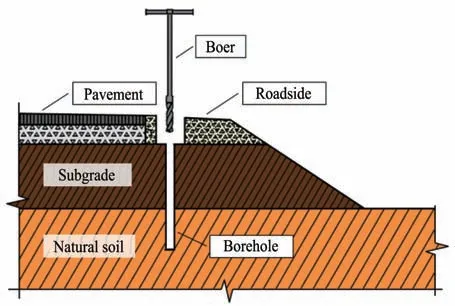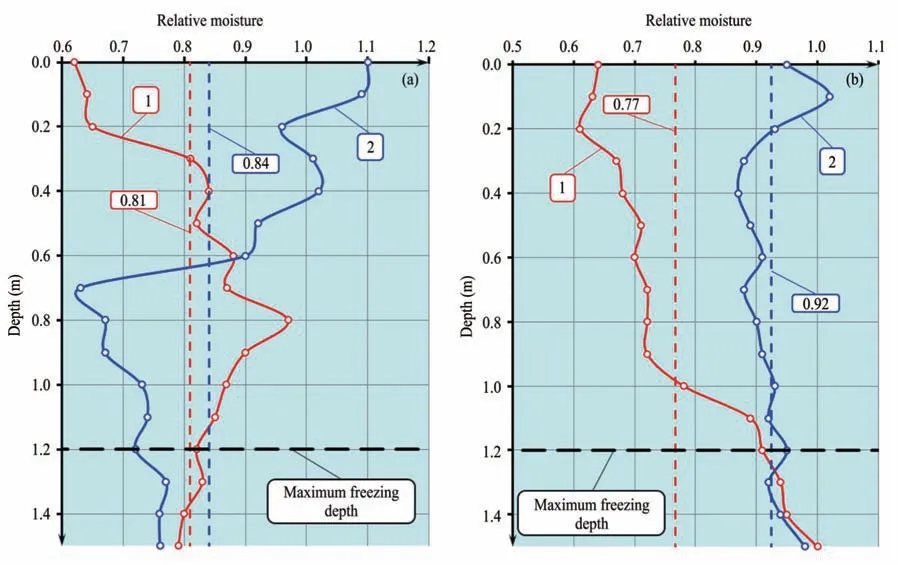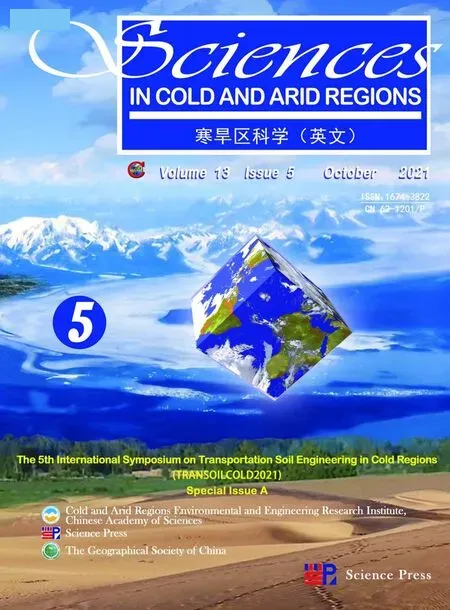Rationale for creation of capillary breaking layersin cold regions subgrade by pressure injection of waterproofing compounds
D.A.Razuvaev,A.L.Lanis,M.G.Chakhlov
Siberian Transport University,Dusi Koval'chuk Street,191,Novosibirsk 630049,Russian
ABSTRACT In the presents work,the authors have carried out a field study of moisture transfer processes in highway subgrades in a cold region during freezing and laboratory experiments on freezing samples of silicified soils used as a capillary barrier.The study showed that the creation of a capillary barrier from an injected solution,blocking the access of groundwater to the freezing zone,will reduce the amount of heaving to permissible values.Based on the results of laboratory studies,an exponential dependence of the relative deformation due to frost heaving on the relative height of soil silicatization in the freezing zone has been established.For creating a capillary barrier in the already existing subgrade,the authors have proposed designs of injection-silicified soils and substantiated the use of such soils.
Keywords:capillary barrier;subgrade;soil injection;silicified soil;cold regions
1 Introduction
The destruction of asphalt pavements in high‐ways due to frost heaving of soils in the subgrade working layer is a problem of great relevance for cold regions(Cambefor,1971;Isakov,2013;Isa‐kov,2018),especially in Western Siberia,of which the widespread occurrence of potentially heaving clay soils and a high groundwater level are typical.There exist many efficient approaches to combat the aforementioned problem,as illustrated in Figure 1.
However,most of the presented methods,which can be conventionally divided into three groups(mod‐ification of soil properties,regulation of the water re‐gime,and regulation of the subgrade's thermal regime),are only used in newly constructed roads or the com‐plete reconstruction of expensive road pavements.Con‐sequently,the economic efficiency of such approaches for existing road sections on which frost heaving defor‐mations begin to appear is not alwaysjustified.
Of the approaches used on existing road sections without dismantling the pavement,such methods as us‐ing surface drainage structures(with waterproofing of roadsides),as well as using surface and deep drainage structures,are often employed.At the same time,on the flat relief of the West Siberian Lowland with a high groundwater level,these methods,mainly aimed at the interception of atmospheric water,proved useless.
For such road sections,we propose considering the injection methods for soils,which are tested and shown to be effective in strengthening highway sub‐grades and railway roadbeds(Kritskii,2013;Lanis,2016;Lanis,2018).The injection of hardening solu‐tions into clay soils was theoretically substantiated in the monograph by Cambefort(Lanis,2019).Since then,this method has been significantly improved and has found wide application for strengthening clay soils in subgrades and roadbeds.With the help of in‐jection methods,it becomes possible to modify the properties of soils in the subgrade working layer or implement a capillary breaking layer at the embank‐ment base without rebuilding the existing pavement and setting a restriction on the traffic.

Figure 1 Methods to combat the destruction of pavement by frost heaving
Due to the large volume of the soil to be pro‐cessed,strengthening the soils of the entire sub‐grade working layer by injection methods or modi‐fying the properties of such soils is a relatively ex‐pensive method;that is why,of the two mentioned methods,the optimum one is the creation of a capil‐lary breaking layer in the highway subgrade by pres‐sure injection of waterproofing compounds.On the other hand,the absence of design justifications and techniques for using such layers allows us to con‐clude that the research along this line presents a vital task.

Figure 2 The investigated road sections.(a)Road section No.1 with deep groundwater("closed"freezing);(b)road section No.2 with a high groundwater level("open"freezing)
2 Results of field tests
The investigated road sections are located on IV-category highways with road pavement of the capi‐tal type along the K-19r highway in the Novosibirsk region(Figure 1).The subgrade of both road sections,including the working layer,is represented by light silty loams.The groundwater on section No.2 was located at a depth of 1.9 m relative to the road sur‐face,and that on section No.1,at a depth of more than 4 m.Due to their respective groundwater table conditions,section No.2 can simulate the subgrade freezing with access to groundwater(also referred to as an"open"system,whereas section No.1 mimics the case with a capillary breaking layer at a high groundwater level or subgrade freezing without ac‐cess to groundwater(referred to as a"closed"system).
At the first stage,we examined the amount of heaving and the rate of moisture transfer in the sub‐grade freezing of the two road sections.To investigate the processes of moisture transfer in the freezing sub‐grade during the cold period of the year,soil samples were extracted(Figures 3 and 4)from the roadbed at the onset of the soil freezing(November)and the maximum frost depth(March)for subsequent labora‐tory evaluation of the moisture content.Additionally,the natural moisture content(W),and the liquid limit(WL),and the plastic limit(WP)of soil samples taken over the depth were determined.

Figure 3 Sampling of soil from study road sections using a hand drill(d=40 mm)

Figure 4 Drilling holes in the subgrade(a)road section No.1 with deep groundwater("closed"freezing);(b)road section No.2 with shallow groundwater("open"freezing)
Based on the laboratory test results,we plotted the dependencies of the relative moisture content of the subgrade soils(the ratio of the natural moisture con‐tent to the liquid limit,W/WL)on the depth from which the soil samples were taken(Figure 5)for the periods of the beginning and end of the intense freezing.
The results obtained have clearly demonstrated the effect of water migration from the underlying soil layers into the water freezing zone.At the same time,a detailed analysis of obtained results on the variation of soil moisture content over depth and time has con‐firmed the known mechanisms and paths of water mi‐gration in the subgrade working layer and the road‐bed,as well as regularities in the distribution of soil moisture.
Meanwhile,a comparative analysis of sections Nos.1 and 2 shows that the simulated presence of a capillary breaking layer(the low possibility for groundwater to reach the water freezing zone at road section No.1)limits the active moisture-transfer zone to a depth close to the freezing depth,and the aver‐age amount of water in the ground layer thicker than the freezing zone(up to a depth of 1.2 from the sub‐grade surface)remains unchanged within the mea‐surement error.Thus,the relative moisture content averaged over the freezing zone at section No.1 proved to be W/WL=0.81 in November and W/WL=0.84 in March.In section No.2,it is observed that the relative moisture content averaged over the freezing zone increased significantly,from W/WL=0.77 in November to W/WL=0.92 in March due to the capillary migration of groundwater into the freezing zone.
Nevertheless,even the presence of a capillary breaking layer does not exclude the possibility of frost heaving of soils due to the atmospheric moisture accumulated in the subgrade working layer before the onset of the intense freezing.In this case,the amount of heaving will vary in proportion to the initial mois‐ture content.In addition,the field of moisture during freezing is formed in such a way that the soils of the upper subgrade zone,down to a depth of 0.5 m from the surface(Figure 5a),during thawing can turn into a free-flowing state.All these factors should be consid‐ered when substantiating the creation of a capillary breaking layer at a subgrade by pressure injection of waterproofing compounds.

Figure 5 The established dependencesof the relative humidity of the soil(W/WL)with depth under the pavement in autumn and spring.(a)road section No.1 with deep groundwater("closed"freezing);(b)road section No.2 with shallow groundwater("open"freezing)1 the beginning of soil freezing period(November);2 the period of soil freezing to the maximum depth(March)
The results obtained are consistent with the mea‐sured amount of heaving on the road surface.Properly aligned surface marks,i.e.,dowels hammered in the autumn period flush with the pavement surface,were used for observing the deformations at each investi‐gated road section.The position of the surface marks was determined by geodetic methods using an optical level relative to the reference time.According to the direct measurement results,it was found that in the spring period the maximum heave of the asphalt pave‐ment in the area with"closed"freezing(section No.1)varied from 0.0 to 2.8 cm.Over the road section with"open"freezing(section No.2),the pavement heave ranged from 3.2 to 5.9 cm.
3 Proposed subgrade structures with capillary breaking screens
Based on our field studies,we have proposed cap‐illary breaking screen(CBS)structures for damaged embankments and depressed highways at a relatively high groundwater level(Figure 6).
The developed CBSdesigns are based on pressure injection technology and present a set of individual soil elements modified with waterproofing com‐pounds.Formation of a hardening solution into clay soils can be achieved by impregnation or in rupture mode on the condition that the injection pressure ex‐ceeds the structural strength of the soil.In this case,the injected solution fills the cracks and loose layers with the formation of a skeleton from the hardened so‐lution and the surrounding compacted soil.Technolog‐ically,this is possible by regulating the pressure and other process parameters while performing the geo‐technical monitoring and selecting an appropriate so‐lution to be injected.Figure 6 shows the CBSdesigns for embankments and depressions formed by injecting hardening waterproofing solutions.Depending on the solution used,the formed geotechnical structure can be created by soil masses impregnated with the binder or include masses of the hardened solution and sur‐rounding compacted soil with minimum porosity.Moreover,the compacted soil also contains layers of the hardened solution formed as the waterproofing solution penetrates the cracks.

Figure 6 Generalized CBSdesigns(a)for embankments;(b)for depressions 1 axes of injectors;2 elements of the capillary breaking screen;3 embankment base;4 groundwater level(GWL)
The degree of soil saturation with moisture will be regulated by changing the filtration properties of the modified conglomerate.Creating a CBS at the subgrade support will yield a criterion of a"closed"freezing system.
As evident from the results of field studies,the worst option for a completed"closed"freezing system is a fully saturated subgrade in the pre-winter period.In this case,the possibility of frost heaving of soils is not excluded,and the amount of frost heaving is de‐fined only by the expansion of water accumulated in the freezing zone in the autumn.In our opinion,for the proposed schemes this fact will not be critical.Results of empirical calculations and experiments Preliminary National Standard(2018)showed that,regardless of soil consistency,the amount of heaving for various types of completely water-saturated clay soils cannot exceed 3%.Consequently,the occurrence probability of deformations exceeding the maximum deformations permissible for highways(Wen et al.,2020)on the pavement surface during the intensive freezing of the soil turnsout to be substantially reduced.
Another problem for the proposed designs is the possibility of transition of the soils in the upper zone of roadbeds to a depth of 0.5 m from the surface(Fig‐ure 5a)into a free-flowing state during thawing,which is accompanied by a decrease in pavement strength.At the same time,a previous study(Yuan et al.,2015)showed that a sharp decrease in road pavement strength will be of a short-term nature since,as the thawing proceeds,the soil stabilizes due to the reverse filtration of weakly bound water.To ex‐clude the possibility of pavement destruction during the period of a sharp short-term decrease in road pavement strength,we propose either to set tempo‐rary limits on the vehicular loads or to use traditional drainage or waterproofing membranes located in the upper part of the roadbed.
4 Conclusions
For creating a capillary breaking layer at the support of existing subgrades,we have proposed de‐signs and substantiated the use of pressure-injected waterproofing solutions.At the same time,further stud‐ies should focus on the injection compounds and filtra‐tion properties of modified soils,the development of a mathematical model for the operation of capillary breaking layers,the most efficient designs of capillary breaking layers prepared from injection materials,and the establishment of a criterion of a"closed"system.
 Sciences in Cold and Arid Regions2021年5期
Sciences in Cold and Arid Regions2021年5期
- Sciences in Cold and Arid Regions的其它文章
- Review and prospect of the effectsof freeze-thaw on soil geotechnical properties
- Stabilizing subgradesof transport structures by injecting solidifying solutionsin cold regions
- Lessonsfrom construction and health condition evaluation of high-grade highway in permafrost regions
- Study on tensile damage characteristicsof sandstone under freeze-thaw cycles
- Numerical simulation of electroosmosis in unsaturated compacted clay
- Field monitoring of differential frost heave in widened highway subgrade
